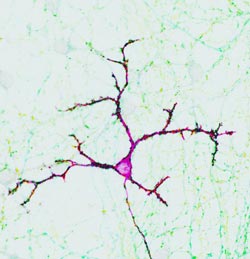New regulator discovered for information transfer in the brain

Neuron with synaptic contacts.<br>(Image: Biozentrum) <br>
Synapses are the most important sites of information transfer between neurons. The functioning of our brain is based on the ability of the synapses to release neurotransmitter substances in a fraction of a second, so that neuronal signals can be rapidly propagated and integrated.
Peter Scheiffele’s team has now identified a new mechanism, which ensures that synaptic vesicles, the carrier of the transmitter substances, are concentrated at their designated place, thereby contributing to rapid signal transmission.
mSYD1 as organizer of synaptic structures
The speed and precision of synaptic transmission is based on a highly complex protein apparatus in the synapse. A concentration of synaptic vesicles is found at the synaptic contact sites between neurons. When a nerve cell is activated, vesicles fuse with the edge of the synapse, the so-called active zone, and send neurotransmitters to the neighboring cells.
Peter Scheiffele’s research group has now identified a previously unknown protein called mSYD1, which regulates the deposition of the vesicles at the active zone. In nerve cells, in which no mSYD1 protein is present, synaptic contacts continue to be formed but the accumulation of the synaptic vesicles at the active zone is disrupted. This results in a significant reduction of synaptic transmission.
Inactive mSYD1 in autistic disorders
These findings provide important new insights into the mechanisms underlying the formation of functional neuronal networks. In patients with a developmental disorder belonging the autism spectrum, mSYD1 is one of a group of genes that are inactivated. In further investigations, the research group is now looking at how the inactivation of mSYD1 affects the behavior of mice, in order to gain insights into the fundamental neuronal defects associated with autism.
Original Citation
Corinna Wentzel, Julia Sommer, Ramya Nair, Adeline Stiefvater, Jean-Baptiste Sibarita, and Peter Scheiffele (2013)
mSYD1A, a Mammalian Synapse-Defective-1 Protein, Regulates Synaptogenic Signaling and Vesicle Docking.
Neuron; Published online June 19, 2013.
Further Information
Prof. Dr. Peter Scheiffele, Biozentrum, University of Basel, phone: +41 61 267 21 94, Email: peter.scheiffele@unibas.ch
Media Contact
More Information:
http://www.unibas.chAll latest news from the category: Life Sciences and Chemistry
Articles and reports from the Life Sciences and chemistry area deal with applied and basic research into modern biology, chemistry and human medicine.
Valuable information can be found on a range of life sciences fields including bacteriology, biochemistry, bionics, bioinformatics, biophysics, biotechnology, genetics, geobotany, human biology, marine biology, microbiology, molecular biology, cellular biology, zoology, bioinorganic chemistry, microchemistry and environmental chemistry.
Newest articles

An Endless Loop: How Some Bacteria Evolve Along With the Seasons
The longest natural metagenome time series ever collected, with microbes, reveals a startling evolutionary pattern on repeat. A Microbial “Groundhog Year” in Lake Mendota Like Bill Murray in the movie…

Witness Groundbreaking Research on Achilles Tendon Recovery
Achilles tendon injuries are common but challenging to monitor during recovery due to the limitations of current imaging techniques. Researchers, led by Associate Professor Zeng Nan from the International Graduate…

Why Prevention Is Better Than Cure—A Novel Approach to Infectious Disease Outbreaks
Researchers have come up with a new way to identify more infectious variants of viruses or bacteria that start spreading in humans – including those causing flu, COVID, whooping cough…



